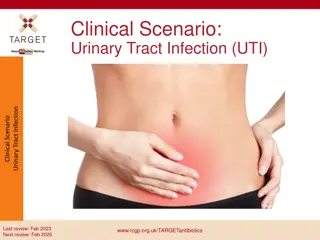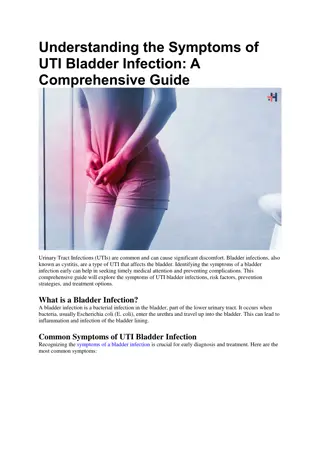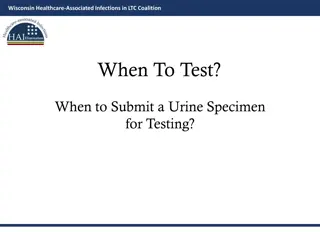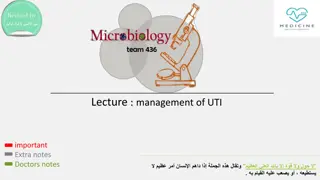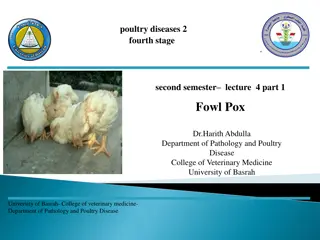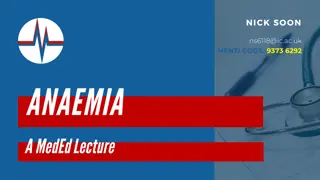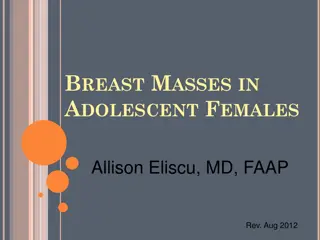Understanding UTI: Types, Causes, Diagnosis, and Management
Explore the comprehensive approach to urinary tract infections (UTIs) covering types (cystitis, pyelonephritis), common organisms, patient presentations, diagnostic techniques, referral indications, management strategies, prophylaxis, and patient education. Understand the impact of UTIs on different patient populations and the key factors influencing UTI management decisions. Gain insights into distinguishing cystitis from pyelonephritis and identifying risk factors for complicated UTIs. Discover the most common organisms causing UTIs and learn about diagnosis and treatment options, including when to initiate investigations and refer patients to specialists.
Download Presentation

Please find below an Image/Link to download the presentation.
The content on the website is provided AS IS for your information and personal use only. It may not be sold, licensed, or shared on other websites without obtaining consent from the author. Download presentation by click this link. If you encounter any issues during the download, it is possible that the publisher has removed the file from their server.
E N D
Presentation Transcript
Approach to Patient with UTI Mohammed Rabeh Aldhaheri Hisham Nasser Almutawa
Question 1 What is the most common organism causing UTI? 1. proteus mirabilis 2. E.coli 3. Klibsiella pneumoniae 4. Pseudomonas aeruginosa
Question 2 Which of the following is considered as a risk factor for complicated UTI? 1. High grade fever 2. Severe flank pain 3. Urinary tract obstruction 4. Female gender
Question 3 Which one of the following is considered contraindicated in pregnant woman? 1. Penicillin 2. Cephalexin 3. Fosfomycin 4. Fluoroquinolone
Question 4 How to differentiate between cystitis and pyelonephritis in urinalysis? 1. Nitrite 2. WBC Casts 3. RBC 4. WBC
Objectives Types of UTI (Cystitis, Pyelonephritis) Causes Common organisms How patient presents Diagnosis When to start full investigations When to refer to specialist Management Prophylaxis Education
What is UTI Infection that affect any part of the urinary tract Types: Upper Lower
Cystitis Infection of the bladder lower urinary tract Complicated Uncomplicated
Patient demographics Pregnancy Advanced age Comorbidities Diabetes mellitus Immunosuppression Renal failure Renal transplantation History of urinary tract infection in childhood Infection characteristics Hospital-acquired infection Uropathogen broadly resistant to antimicrobials Symptoms for seven or more days before seeking care Recent antimicrobial use Recent urinary tract instrumentation Functional or anatomic abnormality of the urinary tract Urinary tract obstruction Prostatic hypertrophy Urethral stricture Presence of an indwelling urethral catheter, stent, nephrostomy tube or urinary diversion
Epidemiology of Cystitis More common in women because of the short urethra. Acute cystitis has been reported to be the most common bacterial infection. In a survey of 2000 randomly sampled women > 18 years, 10.8% had experienced it in the last 12 months
Causes of Cystitis The most common cause is bacterial infection. E.coli in 70% of uncomplicated cases of lower UTI. Other organisms include proteus mirabilis, klibsiella pneumoniae
Presentation of Cystitis Dysuria Frequency Urgency Suprapubic pain Hematuria +/-
Physical Examination It is often not necessary for diagnosis in patient with typical symptoms of cystitis, but if performed it should include : Assessment for fever Costovertebral angle tenderness Abdominal examination
Differential Diagnosis Painful bladder syndrome Bladder lesion (Tumor, calculi) Pelvic inflammatory disease Drug induced cystitis (Cyclophosphamide, allopurinol)
Investigation Urinalysis Urine culture Imaging
Urinalysis Not indicated in patient with typical symptoms. Dipstick Microscopic
Dipstick Leukocyte esterase, nitrites, protein, and blood are the important features in evaluating for UTI.
Microscopic Looks for the presence of white blood cells, red blood cells.
Urine Culture Urine culture is important when diagnosis is not clear or UTI is recurrent. The presence of more than one organism may indicate a contaminated urine specimen and collection and testing should be repeated. The presence of 105CFU/mL of bacteria is the traditional diagnostic indicator for UTI. However, in the presence of dysuria and other symptoms for UTI, 102CFU/mL confirms the diagnosis.
Imaging Studies Indications: History of: Persistent symptoms after 48-72 hours of treatment. Renal stone Patients with pyelonephritis who are severely ill or with symptoms of renal colic Diabetes Urologic surgery Renal transplant Immunosuppression Recurrent pyelonephritis Urosepsis
Uncomplicated Cystitis: Management In women: Nitrofurantoin 100 mg orally twice daily for five days TMP-SMX; one double strength tablet [160/800 mg] twice daily for three days Fosfomycin 3 grams single dose Pivmecillinam 400 mg orally twice daily for three to seven days Fluoroquinolones are good alternatives In men: Trimethoprim-sulfamethoxazole or fluoroquinolones
Complicated Cystitis: Management For patients who can tolerate oral therapy: (5-10 days) Oral fluoroquinolone Ciprofloxacin (500 mg orally twice daily or 1000 mg extended release once daily) Levofloxacin (750 mg orally once daily For patients who cannot tolerate oral therapy: (5-14 days) Levofloxacin 500 mg Ceftriaxone 1 g Ertapenem 1 g Aminoglycoside 3 to 5 mg/kg of gentamicin or tobramycin
Pyelonephritis Inflammation of the kidney parenchyma, calyces, and pelvis Uncomplicated Complicated
Patient demographics Pregnancy Advanced age Comorbidities Diabetes mellitus Immunosuppression Renal failure Renal transplantation History of urinary tract infection in childhood Infection characteristics Hospital-acquired infection Uropathogen broadly resistant to antimicrobials Symptoms for seven or more days before seeking care Recent antimicrobial use Recent urinary tract instrumentation Functional or anatomic abnormality of the urinary tract Urinary tract obstruction Prostatic hypertrophy Urethral stricture Presence of an indwelling urethral catheter, stent, nephrostomy tube or urinary diversion
Pyelonephritis: Epidemiology In the US: 17 cases per 10,000 females/year 4 cases per 10,000 males/year 250,000 new cases/year
Pyelonephritis: Causes Bacteria Gram -ve Escherichia coli Proteus mirabilis Klebsiella spp Citrobacter spp Enterobacter spp Pseudomonas aeruginosa Other Gram +ve Coagulase-negative staphylococci % Uncomplicated % Complicated 70-95 1-2 1-2 < 1 < 1 < 1 < 1 21-54 1-10 2-17 5 2-10 2-19 6-20 5-10* 1-4 Enterococci Group B streptococci Staphylococcus aureus Other 1-2 < 1 < 1 < 1 Bacterial Etiology of UTIs 1-23 1-4 1-23 2
Pyelonephritis: Presentation Fever +/- chills & rigors Flank pain Nausea/vomiting Symptoms of cystitis may present
Pyelonephritis: Differential Diagnoses Urethritis Renal stone Appendicitis Vaginitis PID Prostatitis
Pyelonephritis: Investigation Urinalysis Urine culture Blood culture CT US MRI Urography Renal scintigraphy
Pyelonephritis: Urinalysis MSU Urine dipstick Leukocyte esterase Nitrite Blood Microscopic examination RBC WBC WBC Casts
Pyelonephritis: Urine culture Culture and sensitivity Indications: Persistence or recurrence of symptoms W/I 3 months Suspected complicated UTI Women with acute pyelonephritis
Pyelonephritis: Imaging Studies Indications: History of: Persistent symptoms after 48-72 hours of treatment. Renal stone Patients with pyelonephritis who are severely ill or with symptoms of renal colic Diabetes Urologic surgery Renal transplant Immunosuppression Recurrent pyelonephritis Urosepsis
Pyelonephritis: CT Scan More sensitive than US or IVP Non-contrast CT is the gold standard for renal stone, emphysematous infections, hemorrhage, obstructions, and abscesses Contrast CT visualizes renal prefusion
Pyelonephritis: US Good alternative No radiation/contrast harms Good for stones, obstructions, abscesses
Pyelonephritis: Other Investigation MRI Urography Renal scintigraphy Better in children Not widely available in acute settings
Uncomplicated Pyelonephritis: Management Mild to moderate, not known to be resistant to fluoroquinolones: Ciprofloxacin 500 mg or 1 g ER orally twice daily for 7 days Levofloxacin 750 mg orally once daily for 5-7days Severe, or risk factors for resistance: IV long-acting, such as: Ceftriaxone 1 g 24-hour dose of aminoglycoside, i.e. gentamicin 7 mg/kg
Complicated Pyelonephritis: Management Antimicrobial agent Dose, interval Mild to moderate pyelonephritis Ceftriaxone 1 g every 24 hours Cefepime 1 g every 12 hours Ciprofloxacin 400 mg every 12 hours Complicated Levofloxacin 750 mg every 24 hours Aztreonam* 1 g every 8 to 12 hours Severe pyelonephritis with immunocompromise and/or incomplete urinary drainage Ampicillin-sulbactam 1.5 g every 6 hours Ticarcillin-clavulanate 3.1 g every 6 hours Piperacillin-tazobactam 3.375 g every 6 hours Meropenem 500 mg every 8 hours Imipenem 500 mg every 6 hours Doripenem 500 mg every 8 hours Parenteral regimens for empiric treatment of complicated pyelonephritis
Complicated Pyelonephritis: Management 5 to 14 days course of ABX Levofloxacin Ciprofloxacin TMP-SMX
Children and VUR Vesicoureteral reflux: Retrograde passage of urine from the bladder into the upper urinary tract Presentation: Prenatal: Hydronehprosis Male 1% of newborns Postnatal: Primary, UVJ UTI Secondary, bladder Female Diagnosis: VCUG RNC
Children and VUR Grading Grade I Reflux only fills the ureter without dilation. Grade II Reflux fills the ureter and the collecting system without dilation. Grade III Reflux fills and mildly dilates the ureter and the collecting system with mild blunting of the calyces. Grade IV Reflux fills and grossly dilates the ureter and the collecting system with blunting of the calyces. Some tortuosity of the ureter is also present. Grade V Massive reflux grossly dilates the collecting system. All the calyces are blunted with a loss of papillary impression, and intrarenal reflux may be present. There is significant ureteral dilation and tortuosity
Children and VUR Treatment of Grade I and II Prophylactic ABX to: Non-toilet-trained children BBD Surgical correction for children with BTUTI Treatment of Grade III, IV, and V Prophylactic ABX Surgical correction if: Child older than 3 years Failure of ABX/ side effects / noncompliance
Asymptomatic Bacteruria in Pregnant Women ABU in pregnancy is significant because 20-30% of untreated cases progress to acute pyelonephritis. The US Preventive Services Task Force recommends screening for asymptomatic bacteriuria with urine culture at 12 to 16 weeks gestation. Treatment of ABU in pregnancy consists of oral antibiotics for 14 days. One of the following agents may be used: Amoxicillin Amoxicillin-clavulanate Ampicillin Treatment of ABU in pregnancy reduces the frequency of acute pyelonephritis to 2-3%.
When to Refer Male UTI Patient to a Specialist 1- Symptoms of upper urinary tract infection (pyelonephritis). 2- Failure to respond to appropriate antibiotic therapy. 3- Frequent episodes of urinary tract infection (UTI) - this is stated as two or more episodes in a 3-month period. 4- Features of urinary obstruction (e.g. in older men, enlarged prostate) 5- History of pyelonephritis, calculi, or previous genitourinary tract surgery 6- Any age with painless macroscopic haematuria: 7- Recurrent or persistent UTI associated with haematuria, in a male aged 40 years or older 8- Unexplained microscopic haematuria, in a male aged 50 years or older with an abdominal mass identified clinically or on imaging that is thought to arise from the urinary tract
When to Refer Female UTI Patient to a Specialist 1- Risk factors for complicated UTI. 2- Surgical correction of a cause of UTI. 3- When the diagnosis of recurrent uncomplicated UTI is uncertain.
Prophylaxis of UTI - It s recommended for recurrent UTI patients . - The patient considered if: 1- infected 2 infections in 6 months. 2- infected 3 infections in one year .
Prophylaxis of UTI Continuous vs. Postcoital Antimicrobial Prophylaxis for Recurrent Urinary Tract Infections CONTINUOUS PROPHYLAXIS (DAILY DOSAGE)* 125 to 250 mg POSTCOITAL PROPHYLAXIS (ONE-TIME DOSE) 250 mg IN RETAIL DISCOUNT PROGRAMS ANTIMICROBIAL AGENT Cephalexin (Keflex) COST (BRAND) $14 ($66); only available in 250-mg capsule Ciprofloxacin (Cipro) 125 mg $12 ($68); half tablet (250 mg) for 30 days 125 mg Nitrofurantoin (Macrodantin) 50 to 100 mg $28 ($68) for 50-mg dose 50 to 100 mg


